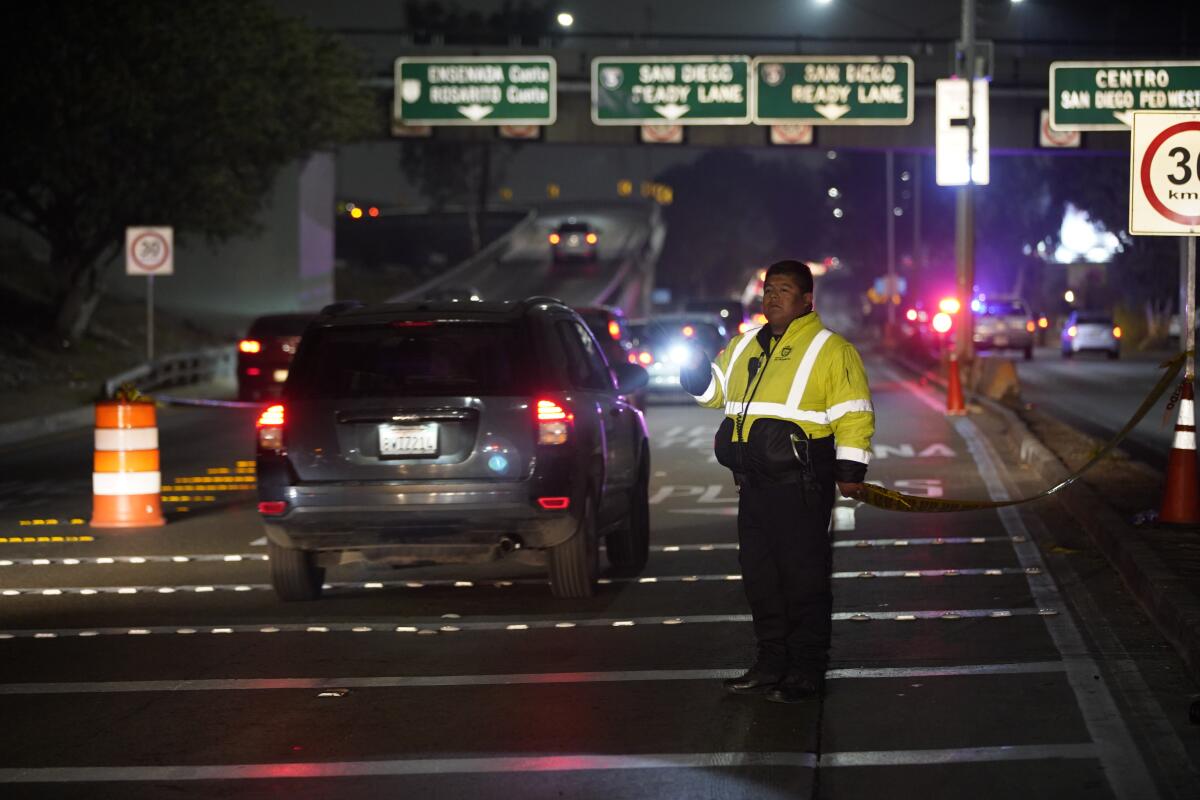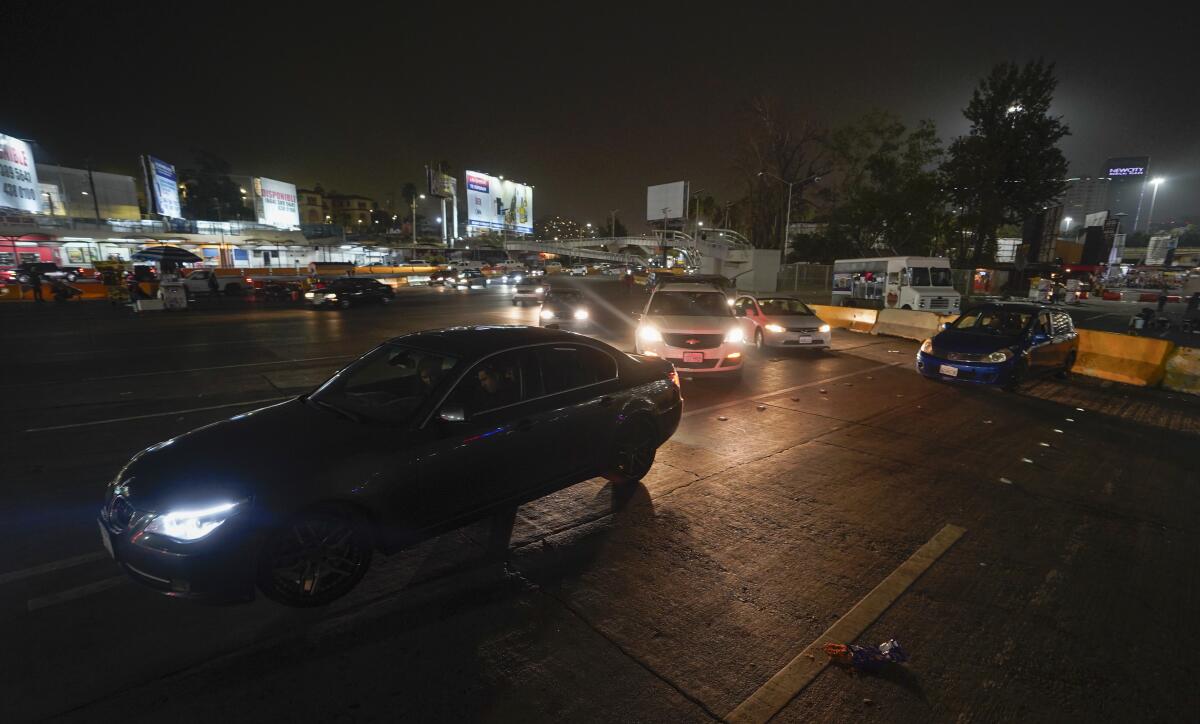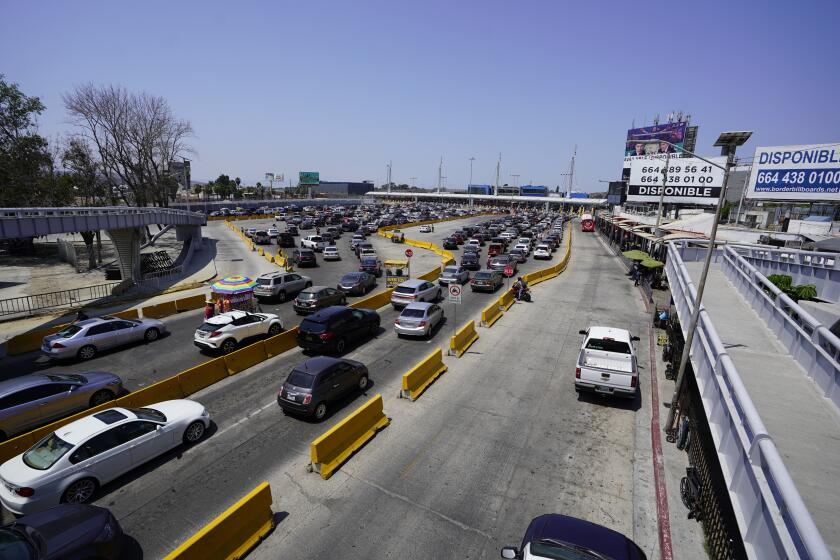Border opens to Mexican travelers after nearly two years of COVID restrictions

- Share via
TIJUANA — International travelers eagerly waited to the side of the U.S.-Mexico border line Sunday night until the clock struck midnight, officially lifting restrictions imposed more than a year and a half ago at the onset of the COVID-19 pandemic.
Hundreds of cars formed lines stretching miles into Tijuana on Sunday night as the wait in the pedestrian line also steadily grew to enter San Diego.
Crossings at the land borders with Canada and Mexico have been largely restricted to workers whose jobs are considered essential. The new rules will allow foreigners fully vaccinated against the coronavirus to legally enter the United States regardless of the reason.

Anticipating emotional and long-overdue reunions with their loved ones, travelers who have been fully vaccinated but unable to previously cross because of a ban on nonessential travel were among the first in line.
Tijuana resident Teresa de Jesús García waited at the San Ysidro Port of Entry with her mother and sister so they could go to Temecula to spend time with another sister and nephews on Monday morning.
“We aren’t going to believe it until we [actually] cross,” García said.
Dozens of other crossings along the U.S.-Mexico border also braced for heavy traffic and long waits at ports of entry. Lines of cars backed up for miles in Mexicali and Nogales, but at the San Ysidro port, traffic was moving steadily and smoothly in the early morning hours.
As of 6:30 a.m., lines at the San Ysidro pedestrian east crossing were not as long as anticipated. During the pandemic, lines would regularly stretch well past the taxi drop-off to the eastern side of the port. Early Monday, the pedestrian line was steadily growing but had not yet passed rows of vendor kiosks to the north of the taxi line.
Restrictions at the Mexican border will ease Monday to allow fully vaccinated people to enter the U.S. for nonessential travel, including tourism.
The COVID-19 restrictions put into place in March 2020 have had enormous economic and social repercussions, especially on communities split by the border. In Mexico, the effects have been devastating on families that depend on the informal work often done during short day crossings into the U.S.
“For too long, restrictions at our border have separated families and devastated businesses that depend on cross-border trade,” San Diego Mayor Todd Gloria said Friday.
The restrictions have mostly kept Mexican citizens with visas or border crossing cards from visiting the United States. That’s because U.S. citizens and legal permanent residents can’t be stopped from returning home to the United States after crossing into Mexico, regardless of their reason. Mexico never closed its northern borders to incoming visitors.
María Galaviz, who lives in San Diego, went to Tijuana on Sunday to pick up a niece who had not crossed the border for almost two years because of the restrictions.
They got into the line to cross back into San Diego about 8 p.m. Sunday, but the line moved much faster than expected.
When they crossed the border earlier than planned, they said, they were sent to a secondary inspection where U.S. border agents asked them to return to Mexico and wait until midnight to cross again.
Galaviz said these months of border closures were very difficult for her family.
“A hug is not the same through a video call as in person,” she said.
As the morning rush hour abated, Tijuana city officials estimated about a 30% to 35% decrease from the usual level of daily traffic.
Javier Delgado, a traffic engineer for the city of Tijuana, said authorities would be keeping a close eye on traffic flows in anticipation of rush hours later in the day or week. He said that people may have tried to avoid the peak hours Monday but eventually would have to cross.
“This is the time when people are trying to cross, and traffic will surely increase in December as the number of border crossings increases,” Delgado said.
The Associated Press and Tijuana-based reporter Yolanda Morales contributed to this report.
More to Read
Sign up for Essential California
The most important California stories and recommendations in your inbox every morning.
You may occasionally receive promotional content from the Los Angeles Times.
















